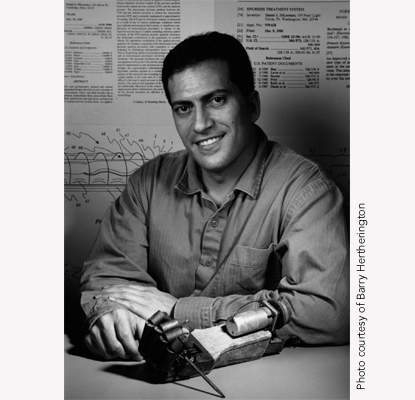Daniel DiLorenzo
From building Erector® sets to circuits and robots, Daniel DiLorenzo has applied his childhood interests in design and building to a career that couples engineering with neurosurgery. His research has led to extensive work with prosthetics, including the development of several medical electronic devices within the health sciences field. In 1999, DiLorenzo was awarded the $30,000 Lemelson-MIT Student Prize.
As an MIT undergraduate, DiLorenzo created, manufactured and marketed his first patent for the Sleep Dry System—an electronic device to train children with bed wetting problems.
One of the first surgeries DiLorenzo assisted in, as a PhD and MD candidate, was an operation to remove a brain tumor in a child, in which dangerous brain swelling occurred toward the end of the procedure. This prompted DiLorenzo to sketch a design that same day to remedy this problem—he later received a patent for his method to control intraoperative brain swelling.
Striving to combine neurosurgery and implantable devices, DiLorenzo devoted much of his work to designing and building implantable microelectrodes to facilitate sensory feedback in prosthetic limbs. DiLorenzo hopes to aid disabled people by providing a more natural feeling for prosthetic limbs.
Among DiLorenzo's other contributions is a functional electrical stimulation (FES) device to control the gait of paralyzed patients, which enabled a paraplegic patient to walk sixty feet with balance assistance. He also patented an invention to treat Parkinson's Disease, in addition to developing other surgical tools and retinal implants.
A native of Fort Washington, Maryland, DiLorenzo has shaped a career with limitless boundaries, earning his BS in electrical engineering and computer sciences from MIT (1987), a PhD in electrical engineering from MIT (1999), an MD from the Harvard-MIT Division of Health Sciences and Technology (1999), and an MS in the management of technology from MIT (1999).
In 2005, DiLorenzo became founder and president of DiLorenzo Biomedical, which he formed to develop "Innovative Neurotherapeutics." DiLorenzo also founded NeuroVista Corporation in Seattle, Washington, (formerly known as BioNeuronics), which raised $33.8 million in 2007 to develop devices for treating patients with epilepsy.
He is currently a neurosurgery resident at Methodist Hospital in Houston, Texas, studying under Dr. Robert Grossman. DiLorenzo is editor of the book Neuroengineering, published in 2007. He is now in the process of launching his next medical technology venture and continues to invent and develop innovative technologies and IP in his field.
His advice to burgeoning inventors: "It is important to be both creative and persistent, to always try to think of a better way to solve a problem. However, the idea is only the beginning of the solution; persistence, tenacity, and resourcefulness are paramount to transforming a mere thought into a solution with impact on mankind. 'Just as the salmon knows not discouragement in its upstream journey, so should it be with any endeavor. One should sense a destiny and relentlessly pursue its realization despite its perceived impossibility.'"


